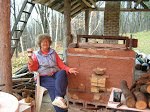
I am having difficulty getting the fishing lady design to fit the curved rim of bowl/plate. The last one I also made the fish bigger - to simplify the design - less fish. I also textured the background on some parts to make areas stand out a bit. I plan to use the water blue under the stony yellow in these areas as that seems to highlight the texture.

Somehow the my applique designs are beginning to loose their appeal to me - they seem now rather old fashioned - sort of 1950's 60's look. The shellac versions also don't seem that successful either. So tried some freer designs - but hard to do for me successfully. Hard to use applique on plates and platter. The one pictured was just an experiment that I did not keep. Instead of applique perhaps I should try a similar design in shellac.

Well we had a functional teapot session at the Guild - members brought in teapots - either commercial or handmade - by themselves or others and we had a testing session to see how they handled and poured (did not get into critiquing form). We had about 30 teapots and could see huge differences among them, mostly in how easy they were to pick up when full. All poured not too badly, though ones with the flaring spouts tended to gurgle or splash when pouring. A few had tea coming out of the lid as well as the spout when first pouring if the teapot was full, even though the spout end was quite high.
I can see Steven's point when he suggested that I make non-flaring spouts. The trouble is I like the look of flared spouts, though I am slowly getting to like the tapered ones. Several Japanese and Xixing teapots poured just beautifully - so smoothly and quiet - these had very small spout openings, and as the teapot was small they fit the form. I never thought that a smooth pour was such a big deal, but after seeing the two types of pours side by side - smooth and gurgling - it is amazing how much better and classy a smooth pour is.
We decided if the teapot held more than 2 cups, a side handle should also have a small lug above the spout to help in lifting the pot, or else an overhead handle should be used. Side handles also needed thumb stops to help with the lifting.
The flat bottomed teapots seemed too heavy for a side handle and so an overhead handle would have been better.

On my teapots I do not like the steam hole in the lid as it detracts from the lid form unless it can be hidden by a knob. So I have been putting the hole in the rim of the pot at the side opposite from the spout. However when there is a side handle, a finger might be placed over the hole when lifting the pot - and this could cause an uncomfortable hot spot on the finger so will have to be careful in placing the steam hole in relation to side handles.

2 comments:
sorry you didn't like the applique bowl, i thought it looked great. just found your blog
Hi Jim - I find that making rapid loose marks very difficult as in the center of the bowl and the loose squishes along the appliques. I guess because I do not work in series I do not work up enough looseness. But I love the loose look - but very hard to make it look right.
I visited your blog - great stuff. Very unique - elegant so fits your elegant beautifully. Looks like slip under some resist or resist alone and then washed off like in my shellac resist?
Post a Comment